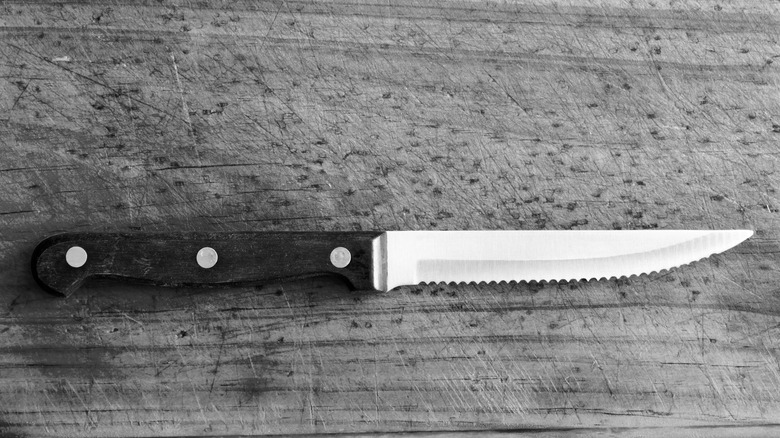Why You May Want To Avoid Buying Serrated Steak Knives
Serrated steak knives may seem like the obvious choice to effectively slice through different cuts of meat. After all, the little tooth-like ridges are there for a reason, right? But knife connoisseurs caution you to avoid buying serrated steak knives. That is if you enjoy a juicy steak.
Serrated steak knives can tear and rip the fibers in the meat, damaging it and leading to leakage of all that yummy juice inside. It makes sense when you think about it. Typically, with serrated knives, you have to saw back and forth to make a cut. This can compromise texture and result in a less clean and precise cut. "In my experience cutting many steaks over the years, non-serrated knives cause less juice to release because they slice more cleanly," YouTube reviewer Prudent Reviews commented on a test video comparing the two types of knives. "Regarding flavor, the mouthfeel of the cleaner slices tastes better to me, and since they are usually more juicy, the flavor is better."
More downside to serrated knives
Although serrated knives will typically stay sharper longer since the space between the scalloped ridges never touches the plate or cutting board, they require more legwork than a non-serrated or straight knife. Serrated knives are more difficult to sharpen on your own because you can't use a whetstone or most electric sharpeners; instead, you have to go serration by serration with a sharpening rod. A Reddit user summed up serrated knives and their utility like this: "They mutilate your meats and are impossible to sharpen at home."
With their jagged edges, serrated knives can be more challenging to clean thoroughly than straight knives. The small crevices and grooves created by the serrations provide the ideal hiding spot for food particles, which can lead to bacterial growth. The uneven edges make them more challenging to clean, especially if the knife is not washed immediately after use and the food residue dries.
What should you be using a serrated knife for?
But there can be a place for serrated knives in the kitchen, even though it may not be cutting steak. Serrated knives excel at specific cutting tasks where a straight blade might struggle. Their unique design makes them particularly well-suited for slicing through foods with tough exteriors and soft interiors. One of the best uses for a serrated knife is slicing bread. The teeth grip the crust while the sharp edge slides through the soft interior, resulting in clean slices that don't squish the loaf.
They are also ideal for cutting through delicate items like ripe fruits or tomatoes without crushing or tearing them apart. Their saw-like action makes quick work of these tasks, allowing for precise cuts with minimal effort. Serrated knives are also especially handy for slicing through tough-skinned vegetables like bell peppers or eggplants and trimming or cutting layers in cakes.


